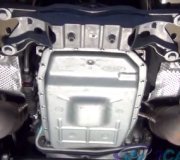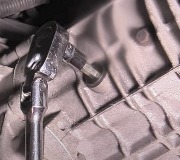It takes time for metal to corrode away. In every single case of a leak, there was a leak one day and it was not leaking the day before. There are a lot of things that can take place in between, including a regular service to include a quick inspection. Sometimes I like to sarcastically reply that the leak, or some other problem, developed right after you filled with fuel, right after you pumped up a tire that was low, right after you hit a pot hole, or heaven forbid, right after you made too many right turns after dark! The point is the problem was not there the last time the mechanic had the car, and in fact, you were not noticing that problem yet either at that time. Believe it or not, there are way too many people who blame us for not finding a problem that shows up weeks or even months after we last saw the car. We call that "being married to the car", or in my first lifetime, "being married to the TV". That means we are responsible for everything that goes wrong for the rest of the time the customer owns that product. Of course we are being sarcastic, but that is how it feels sometimes.
With transmission coolers in radiator tanks, these leaks start out real small and generally stay that way because the radiator gets replaced before the leak gets worse. It is common to see a little brown sludge in the coolant reservoir, and we usually overlook that, but over time, if the cooler really is leaking, that sludge build-up will get worse to the point we cannot dismiss it as normal.
While this can happen to any brand of car, it is most common on GM products because of one of their business practices. They advertised their coolant as "lifetime" antifreeze to make their cost of regular maintenance appear to be lower than that of their competitors, ... One of their marketing tricks. Then, they place a sticker under the hood that says to replace it every three years. In fact, the Dex-Cool company that makes that antifreeze does not even recommend that. They specify the same two-year interval as all other antifreeze manufacturers. The antifreeze will always be antifreeze. It is the additives in it that wear out in about two years. We replace antifreeze to replenish those additives which include water pump lubricant, corrosion inhibitors, and seal conditioners. Acids normally do build up in cooling systems so the additives are needed to neutralize them. The more common failures are heater cores and radiators leaking coolant externally. GM owners are very familiar with that.
For your car, this is not a serious repair as long as it has not been going on too long. Antifreeze that gets into engine oil will dissolve the soft first layer of metal engine bearings. There are bushings made of the same material in automatic transmissions. That is the biggest concern for having the transmission flushed. Most shops have a special machine that gets one hundred percent of the old transmission fluid out.
The biggest concern with getting transmission fluid in the cooling system is it slowly rots rubber hoses from the inside. Given the age of your car, you might be due for hose replacement just out of principle and preventive maintenance, but if that was done recently and transmission fluid has not been in there very long, a cooling system flush and refill should be sufficient.
Wednesday, April 25th, 2018 AT 3:45 PM


